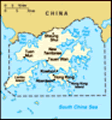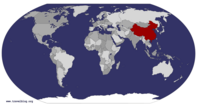Advertisement
Published: February 9th 2013
HONG KONG For the national holiday, where better to head to escape crowds of people than a city-state of 7 million: Hong Kong. Formally a Special Administrative Region of the PRC, it is also known as Honkers, as I was informed by my guide to all things Chinese (who herself hails from the Special Administrative Region of Wales). After handover in 1997, Hong Kong became Chinese but because of its differences in economy and society compared with the mainland, the government could not allow complete integration. Hence the one-country-two-systems arrangement that exists. Travel between Hong Kong and "Mainland China" is not free: you have to go through immigration.
On arrival the "mist", originating from the mainland factories, hung thick and low over the city, so that the plane seemed to land in the cloud. Sadly, this weather was to stay for the whole four days, trapped here by the lack of wind, with only intermittent sunshine penetrating it. The temperature was however on the warm side of pleasant.
Staying in Wan Chai on the island, it felt very built up, busy and cramped. Lots of small shops and restaurants on street level, with many neon signs hanging at
first floor level above the roads. Lots and lots of small apartments are arranged above this in tall, thin tower blocks. Their narrowness makes them appear much taller than they are. The air conditioning units (always separate external ones for each apartment) here frequently dripped condensation, so that you are constantly dodging large drops of man-made rain. Apparently the streets of Honkers were the inspiration for the street scenes in Blade Runner. Perhaps the synthetic weather was too.
On my first night I met with les Française, and we walked under the neon signs overhanging the streets, past the luxury goods shops to Victoria Park which, like its counterpart in London, is located east of the City. Unlike its counterpart in London, tonight it was hosting a fire dragon dance. We passed between some spectacular lantern displays along with thousands of other people to arrive at the dragon enclosure. The wait was excruciating, and compounded by the constant fear of rain, and lengthy Cantonese interviews on the big screen TV. But eventually a long dragon appeared, chasing two giant balls of fire! The dragon and balls were constructed from burning incense sticks fixed to a wooden frame, carried by
dozens of people. It performed for about twenty minutes, winding its way around an enclosure, until the incense started to die out. Actually it was not really a fire dragon, but an orange-glowing, smoking, sweet-smelling dragon, but it was nice to see anyway. What was more impressive was the huge display of lanterns all around the park. It was really a festival of light.
THE PEAK
The next day we climbed the Peak. Well, we took the funicular railway, known as the Peak Tram, but at least we did walk back down. Surprisingly, like the 上海metro, I found myself fighting with an old Chinese lady who didn't like the idea of queuing. The cable car was another antiquated British installation. It was installed in 1926 for residents of the Peak but mostly for tourists wishing to get the fine views of the city from the top. Apparently, it killed off the former Peak sedan chair business overnight. The original fee structure had the third class designated for animals and people other than colonial officers and residents.
The tram arrives at a horrible modern shopping plaza. However we quickly escaped this and took a
stroll to the Peak Park; on our way passing a group of women walking their dogs. The unusual thing was that the dogs were wearing not only clothes but shoes. One of them only on its front paws.
A quick stroll around the park, up and down many steps brought us to a pagoda at the top of the Peak (or as near to the top as you can go). We returned to the tram, but decided to skip it and walk back to the city: it's only 400 vertical metres. It turned out to be a good idea, as it not only avoided the wait, but led us to the longest outdoor escalator in the world (recommended by my guide); and even better, a very nice Thai restaurant.
FIREWORKS
That evening we watched a firework display over the harbour. In fact, it was the most spectacular firework display I think I'd ever seen. Twenty minutes of massive explosions. Apparently better to watch from Kowloon with the City skyline as backdrop, our view was however also pretty special. The fireworks were for the National Day. That's the National Day of the PRC.
Certainly, whoever paid for the fireworks was of the belief that it was more one country than two systems.
Only the next morning did we learn that there had been a collision in the harbour and a ferry had sunk killing dozens of people travelling from Lamma island to see the fireworks. Victoria Harbour is one of the busiest shipping channels in the world. Thankfully, serious incidents are very rare.
STANLEY
Many small things in Hong Kong look like the UK. Many of the place names, for one: Stanley, Victoria Park, etc. The street signs are another; the shops have more brands from home; and even the buses and the metro have little touches of London. They also drive on the left; which would also create a problem if integrated with the mainland.
Stanley is located on the south of the island. Its architecture is different from the big city to the north. Rather, it's completely reminiscent of a faded British seaside town (helped by the weather): with a small beach, an esplanade with turn of the century pubs on it and a new shopping centre nearby. If
only I could find somewhere to park my dog.
BIG BUDDHA
It's not the biggest Buddha in the world. Neither is it the biggest outdoor Buddha or the biggest seated Buddha, or even the largest bronze Buddha. But, the Tai Tant Buddha on Lantau island is the biggest outdoor seated bronze Buddha in the world. Justifiably called "big Buddha" it stands at 34 m high including the base. Our day began with a trip to the island and a long climb to the top of the statue. We were rewarded with ice cream, included in the ticket price. We then visited the large Po Lin monastary, which was even being expanded.
The setting for these religious (and touristic) sights is the mountainous, forested landscape typical of Hong Kong. Having taken our fill of Buddhism for the day, we decided to hike back the 8 km or so to Tung Chung. In began as a pleasant stroll through the trees. The views of the hills were pleasant, the path easy, and the sun pleasant. There were some idyllic spots on the route: ancient gates, clearings affording great views, a bridge across the river. However,
the path soon became narrower and more overgrown. Itself, this was not a problem. The problem was the giant spiders hanging overhead. Appearing the size of the face-huggers in Alien, they were ideally positioned to drop onto the heads of unwary hikers walking the path. OK. Maybe not as big as a face-hugger, they were quite intimidating. We very carefully picked our way underneath Shelob and family, and fortunately they did not move to attack. From then on our pace slowed considerably, as we avoided more clusters of the giant spiders, and scanned all around for other nasty creatures such as snakes. It was only on our return that we discovered these were golden silk orb weavers. Carrying a venom similar to the Black Widow (although not as potent), and becoming aggressive if disturbed by a threat, they can cause serious harm, but usually not death. Something to bear in mind if I meet one again.
To settle our nerves, that evening we enjoyed a few drinks in the good time area of Lan Kwai Fong. As well as the welcome drinks, the loud music in the bars here certainly provided some yang to the yin of the serene
Po Lin monastary.
NOON DAY GUN
The Noonday gun is fired everyday at (you guessed it) noon. The tradition originates as follows: One of the Hongs (massive Cantonese trading companies), Jardines, was located in the area known as East Point. When one of their ships arrived into port, they would fire a welcoming gun salute from East Point. However, on one occasion in the 1860's a senior British navy officer, who was new to Hong Kong and unfamiliar with the practice (which was ordinarily reserved for government officials and senior military officers) ordered Jardines, as a penalty, to fire a gun every day at noon, forever.
Presumably it was originally located on a peninsular, where it would be visible to passing ships. However, the gun is currently located on a small dock, isolated from the city by a motorway, and next to a building site. It's the kind of location where you would expect to find an abandoned car or a warehouse full of old washing machines. Accessible via a tunnel, through an innocuous doorway in a side alley on the city side of the motorway, it is also rather a small gun;
although to its credit it is very well polished. There was a handful of other tourists looking as lost as us, awaiting the ceremony to start. First, we observed a minute's silence for the victims of a ferry disaster on 1 October. Then a man in a uniform climbed on to the platform and fired the gun. It made a loud cracking sound and a little puff of smoke. Then he climbed down, and we were allowed to walk around the little enclosure and take some pictures. Not a life-changing 15 minutes, but it was educational: it had a feel of understated colonialism about it.
SEEING STARS
My last day, I took a visit to Kowloon to see the sights there, and do some shopping. This half of the city is on the peninsula, and the feel is much more Chinese. Its bigger, newer and much more commercial. To get there I took the Star Ferry across the harbour form Wan Chai to Tsim Sha Tsui. It's public transport so, like the tram, was incredibly cheap. It also has an early twentieth century British feel about it: a feel of engineering, craftsmanship and being
slightly too small to be comfortable by today's standards. Unlike the tram, however, the ferry gives a spectacular view of the City skyline.
Kowloon is full of jewellery shops, clothes shops and camera shops. The two highlights I saw were Kowloon Park and The Avenue of Stars. The former is divided into several sections with different themes, and is full of sculptures. The latter is a promenade located around the harbour. It's a celebration of the Hong Kong film industry, and consists of a number of hand prints of famous actors sunk into the pavement. There are also a few information boards and statues: the most striking, and most photographed being of Bruce Lee. At the ferry terminal end of the Avenue was another large display of lanterns. This one was of larger-than-life people and horses pulling a carriage. It would have been nice to see it at night.
After a farewell visit to one of the holy trinity of modern Chinese cuisine: starbucks (the other two being McDonald's and KFC), I left the les Française to enjoy a few more days of the quaint city of Hong Kong, and returned to the huge expanse of 上海 and
to work.
Advertisement
Tot: 0.089s; Tpl: 0.011s; cc: 8; qc: 47; dbt: 0.038s; 1; m:domysql w:travelblog (10.17.0.13); sld: 1;
; mem: 1.2mb


















